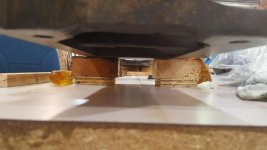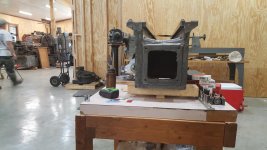learning80
Plastic
- Joined
- May 10, 2018
Hi all I have been scraping a grinder table and didn't initially give much thought to how to support it while scraping, I just scraped it on an old wooden work bench. I moved it to a friends place and put it on his surface table and the alignment value I am getting from the King way type tool I made has changed. The ways consist of a flat way and an inverted V.
Question is do I put it on a surface plate which supports it everywhere evenly to check for alignment? Or should I be supporting it at the Bessel points or something?
Many thanks.

Incidentally my method of scraping for alignment was to scrape both sides of the V flat first, then scrape the flat part flat. After this is done there will be misalignment in the sense of the top of the 'new V' being out of alignment with the flat part. Then my plan was to make the alignment tool and rescrape the flat part until the imaginary top line where the sides of the V meet were in line with the flat.
Image of it being out of alignment (the angle of 120 degrees is random, obviously it will be something other than this):

After this is done I hope to match the ways of the saddle with the table using the table as the master. No doubt there will be more considerations once I get to that stage.
Question is do I put it on a surface plate which supports it everywhere evenly to check for alignment? Or should I be supporting it at the Bessel points or something?
Many thanks.

Incidentally my method of scraping for alignment was to scrape both sides of the V flat first, then scrape the flat part flat. After this is done there will be misalignment in the sense of the top of the 'new V' being out of alignment with the flat part. Then my plan was to make the alignment tool and rescrape the flat part until the imaginary top line where the sides of the V meet were in line with the flat.
Image of it being out of alignment (the angle of 120 degrees is random, obviously it will be something other than this):

After this is done I hope to match the ways of the saddle with the table using the table as the master. No doubt there will be more considerations once I get to that stage.




